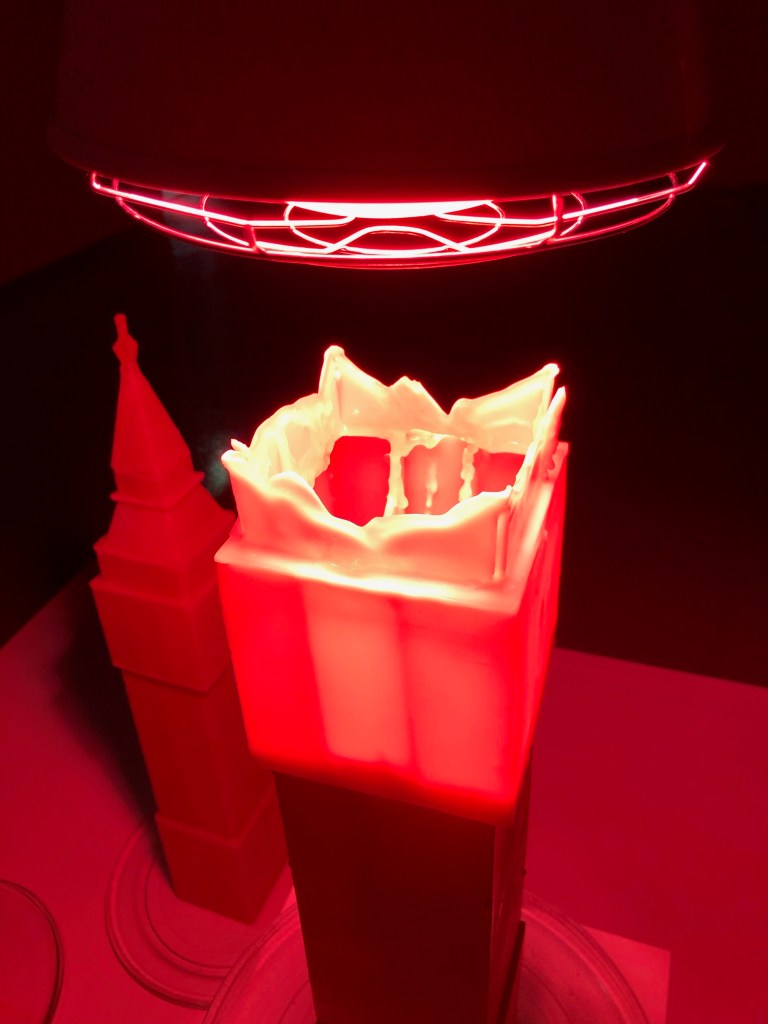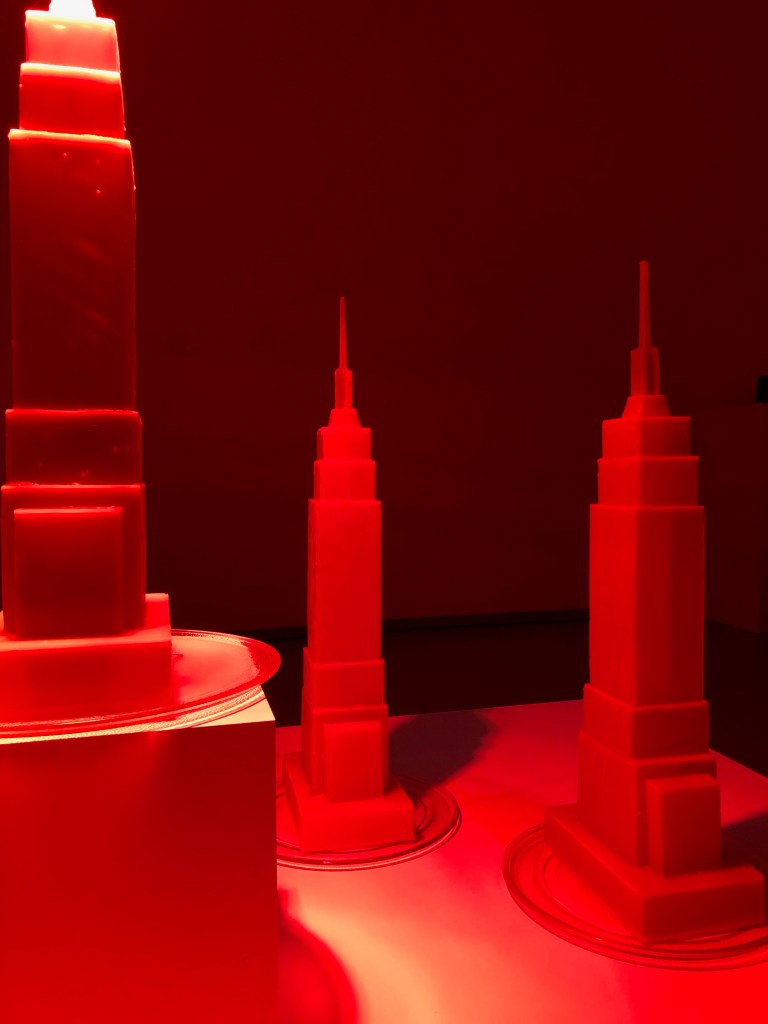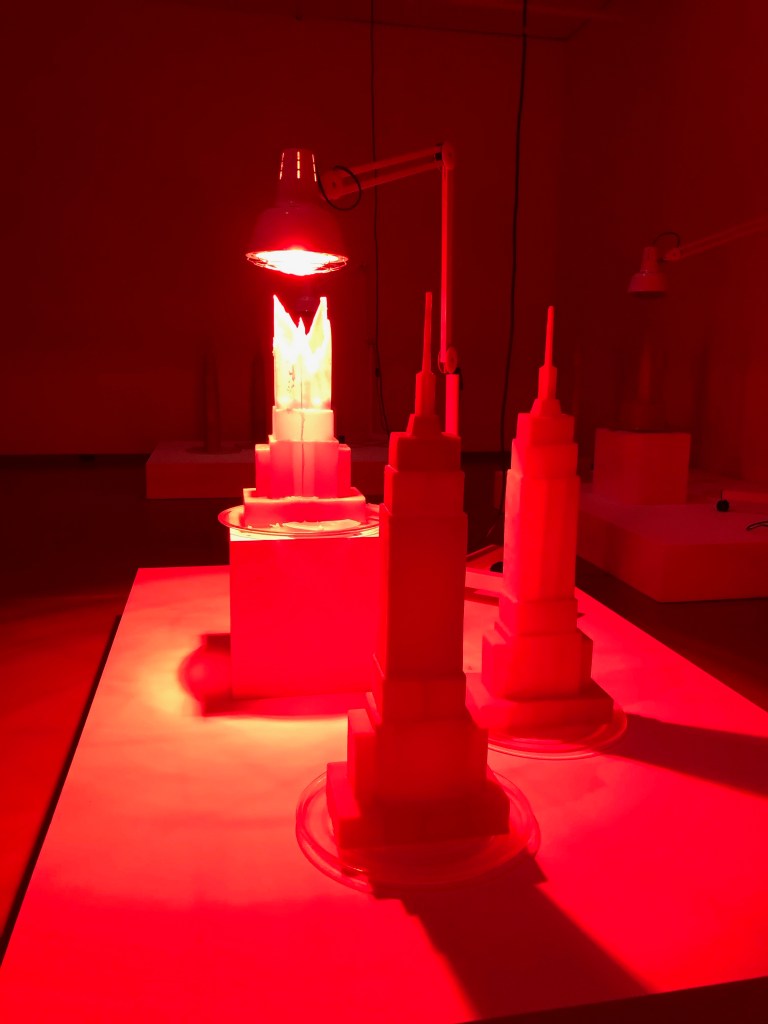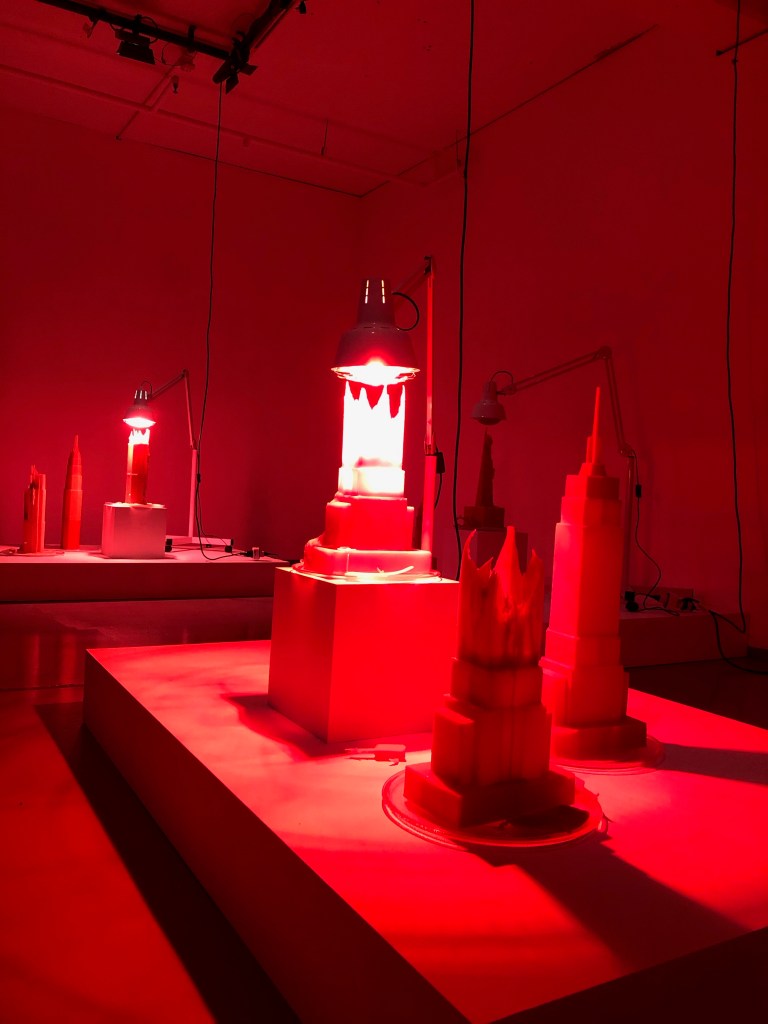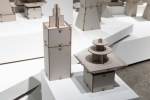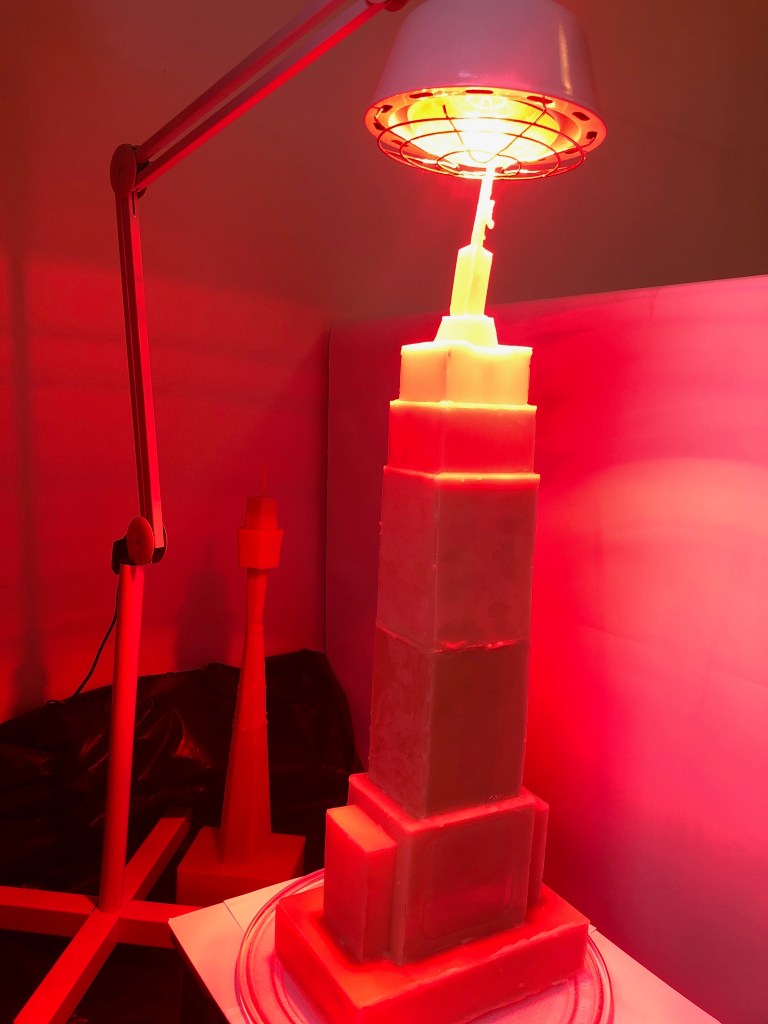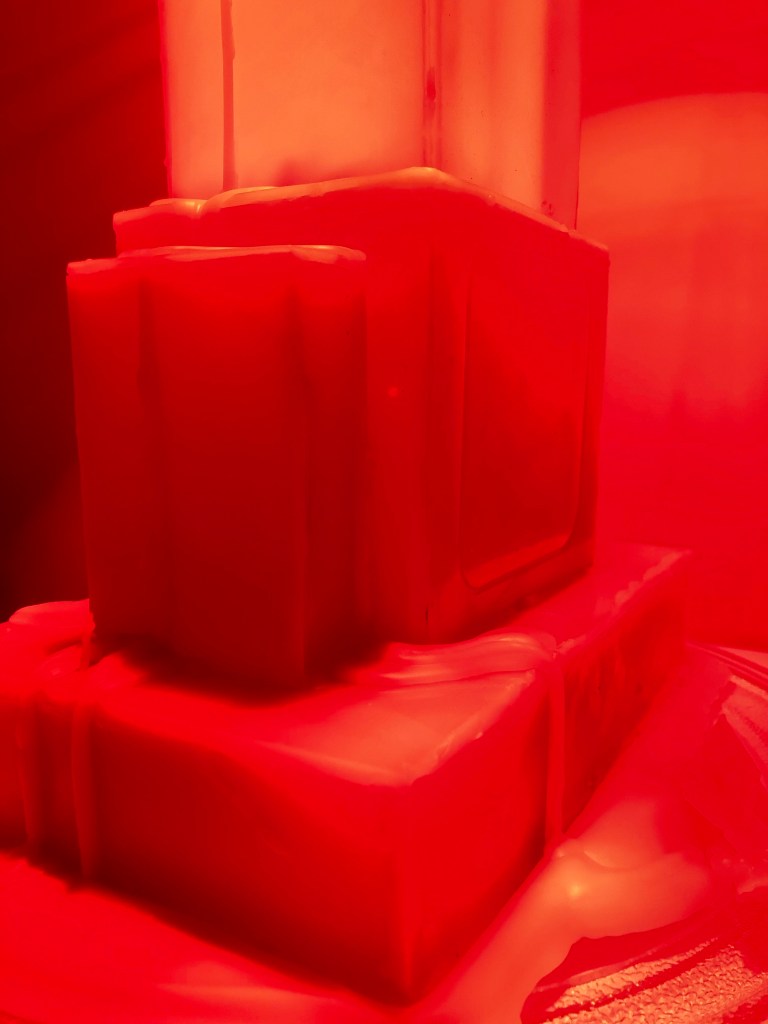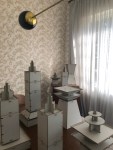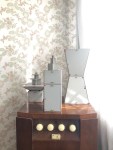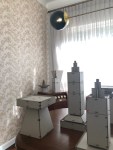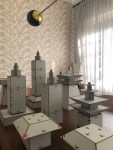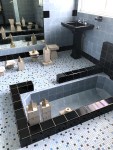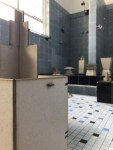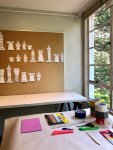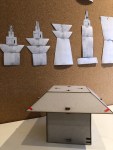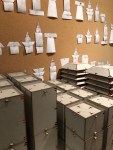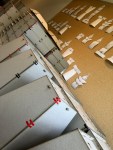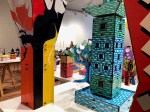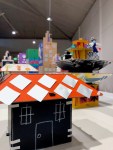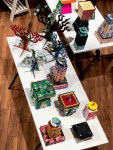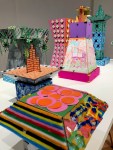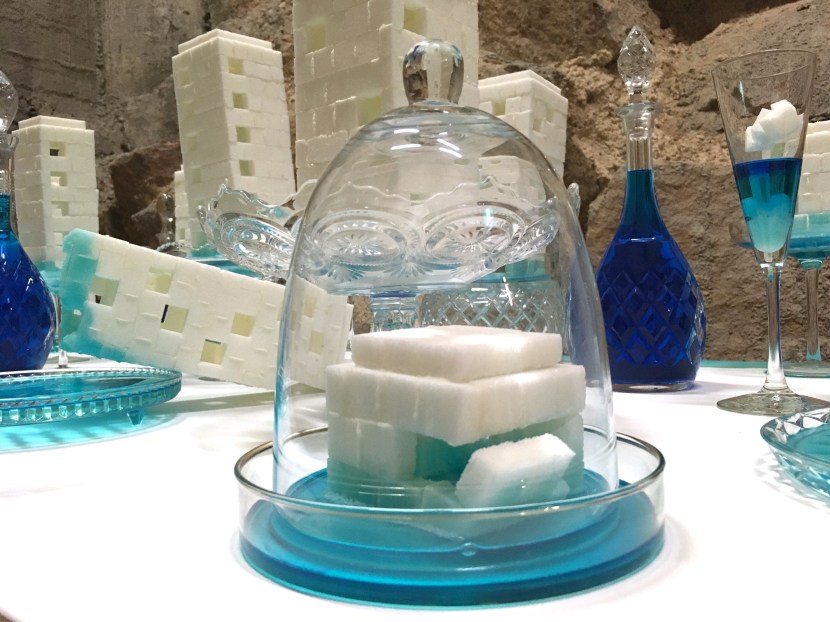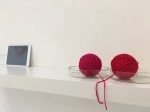Category: Miniature Cities
Soft Science City in Cities Foretold

Soft Science City will feature in the group show Cities Foretold.
Soft Science City highlights the fact that the metropolis is always in flux; it’s a work-in-progress, a kind of dynamic experiment in coexistence. In Soft Science City cold rational laboratory glass meets warm soft knitting. And here, these opposites not only attract, they are inextricably linked. Working together they form a mini-metropolis in which fuzzy logic is made manifest. In other words, there are no precise solutions offered by this experiment, no single right answer. But it does point out that diversity and inclusion are key factors in creating a thriving city.
Cities Foretold
1 Sept – 2 Oct
Art Space on the Concourse
Chatswood, NSW
Behind the Velvet Rope: Soon it would be too hot 2
Behind the Velvet Rope: Soon it would be too hot 2, was ubs at the Coal Loader as part of the 2022 North Sydney Art Prize.
Behind the Velvet Rope invites us to watch the spectacle of the climate crisis in action—again.
This work asks us to reflect on our own consumption—not only of fossil fuels, such as coal—but of the mesmerising scenes of devastation that we, collectively, have wrought. Seeing this work in the Coal Loader tunnels will infuse the work with both site-specific poignancy and a sense of urgency.
2022 North Sydney Art Prize
The Coal Loader Centre for Sustainability
2 Balls Head Drive, Waverton
14 – 29 May 2022
Soon it would be too hot (instal timelapse)
Soon it would be too hot melting at the Casula Powerhouse Arts Centre, 12-14 Feb 2021.
Soon it would be too hot
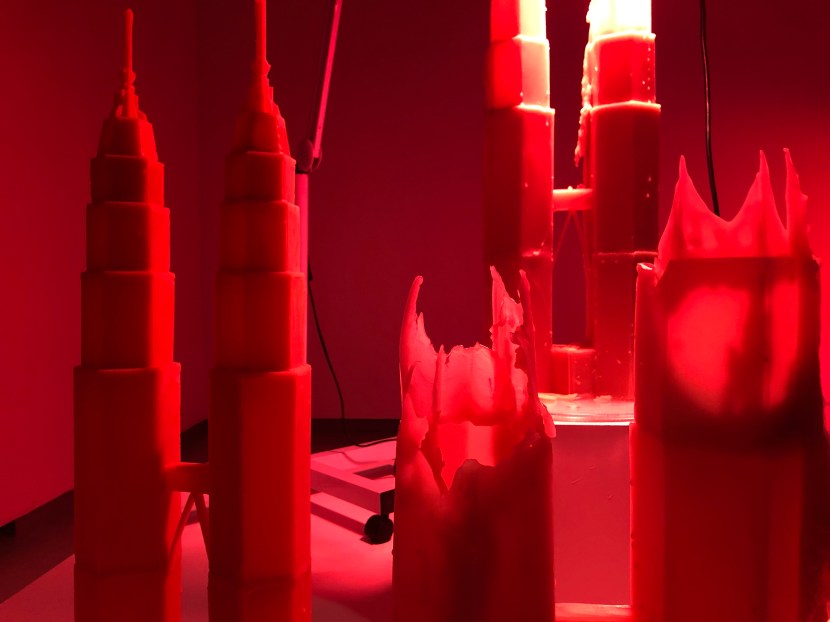
Soon it would be too hot is the first line of JG Ballard’s novel The Drowned World. Written in 1962, during the perpetual slow-burning crisis of the Cold War, it reads like a prescient vision of our current climate crisis.
Tracey Clement, Soon it would be too hot, 2021. Melting at Casula Powerhouse Arts Centre, 12-14 Feb 2021.
And here in Australia it is already too hot. Way too hot.
In the catastrophic bushfires of 2019-2020 climate change was made manifest: terrifying, deadly and spectacular. In fact the devastation was so lethal, so massive, such a spectacle, that the global media actually took notice. For a brief moment Australia was the unlucky country; a place where the reality of anthropogenic climate change could be observed wreaking havoc in real time.
It should have been a wake-up call. But then, still reeling from the bushfires, the coronavirus pandemic hit and the climate emergency fell out of the news cycle. But, of course, that doesn’t mean it has gone away. The climate crisis is still bubbling away, heating up, threatening all life on earth.
Tracey Clement, Soon it would be too hot (Big Ben), 2021. Melting at Casula Powerhouse Arts Centre, 12-14 Feb 2021.
In Soon it would be too hot multiple versions of the Eifel Tower, Sydney (Centrepoint) Tower, the Empire State Building, Petronas Towers, and Big Ben melt over the course of the exhibition. As these five iconic towers succumb to relentless man-made heat they are a bold graphic reminder that climate change didn’t just happen – we made this crisis.
And if the upward thrusting towers in Soon it would be too hot represent the anthropocentric, arrogant, individualistic, patriarchal culture which led to the climate crisis – characterised by the attitude that big is always better, too much is never enough and the natural world is a resource to be exploited for human gratification – then beeswax, the material they are made from, symbolises an alternative: a matriarchal, nonhuman and collective social structure.
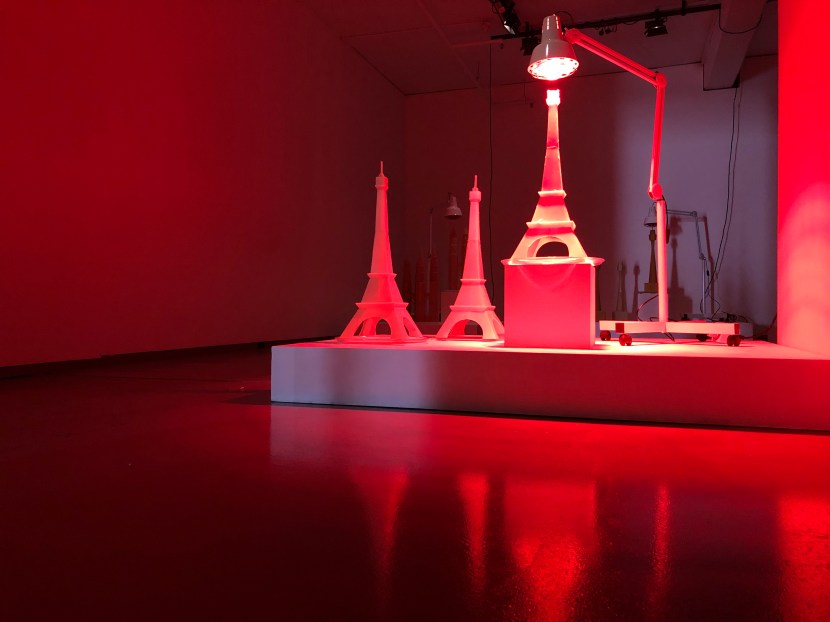
As temperatures in Australia continue to rise summer has become an increasingly dangerous season – when we aren’t literally burning we are metaphorically melting. Soon it would be too hot seeks to keep anthropogenic climate change front and centre in the public consciousness, not to point the finger, but to spark action and kindle hope. Yes, we are all culpable, but we are also the only ones that can address this crisis. And we can do this together, working collectively.
Soon it would be too hot: Eiffel Tower
In Soon it would be too hot, anthropogenic climate change is made manifest as iconic towers from around the world succumb to relentless man-made heat.
Here the Eiffel Tower melts at high speed.
Tracey Clement: Soon it would be too hot
Casula Powerhouse Arts Centre
23 January – 21 February 2021
Mix and Match City

Tracey Clement, ‘Mix and Match City,’ 2020, laser-cut recycled cardboard, tape, glue, dimensions variable (40 units). Installed in ‘The Home’ at Hazelhurst Arts Centre. Photo: Silversalt.
Mix and Match City is a mini-metropolis that deliberately draws on the inherently aspirational symbolism of architectural models. All architectural models represent an idea, a vision for the future made manifest in miniature. They are real, but not fully realised. Infused with potential, they are liminal zones tinged with hope.
Mix and Match City was exhibited in the group show THE HOME at the Hazelhurst Arts Centre 29 August – 8 November 2020.
Watch me talk about the work in the video below at approx 4.25 mins.
Soon it would be too hot: work in progress

Soon it would be too hot is the first line of JG Ballard’s 1962 novel The Drowned World. It is also the title of my solo show which was exhibited at the Casula Powerhouse Arts Centre, 23 January – 21 February 2021.
These work in progress pics show early melting tests and wax prototypes.

Tracey Clement: Soon it would be too hot
Casula Powerhouse Arts Centre
23 January – 21 February 2021
Mix and Match City at Hazelhurst (dining room)
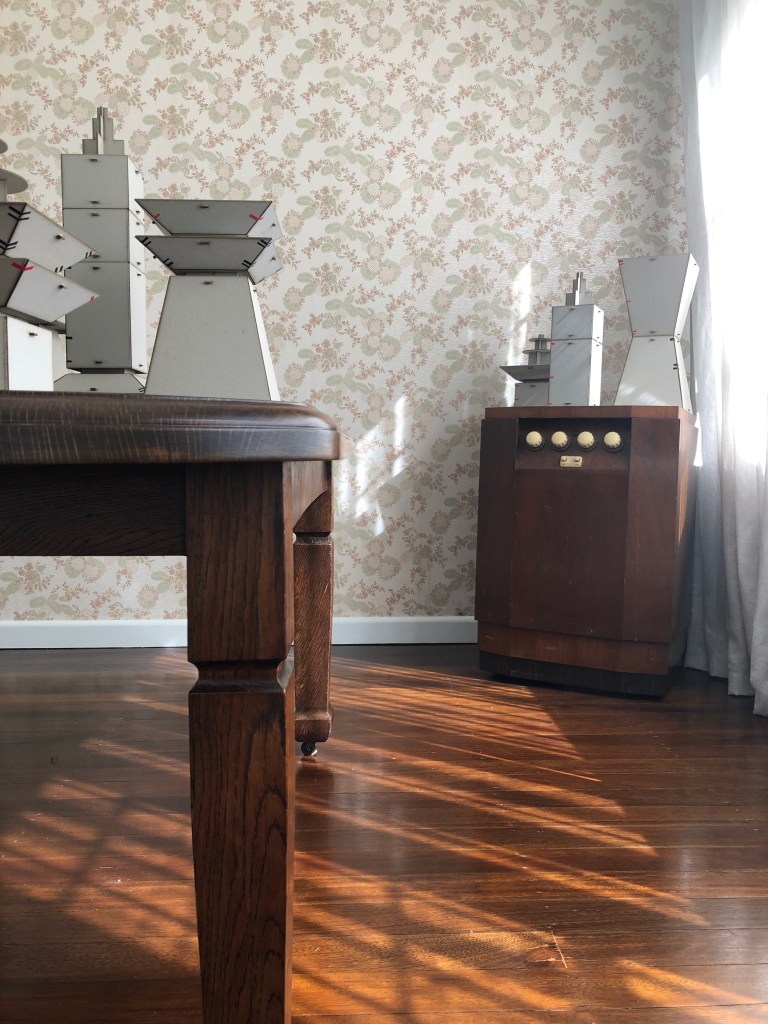
Tracey Clement, ‘Mix and Match City,’ 2020, laser cut recycled cardboard, tape, glue, dimensions variable. Installed in the dining room of the cottage at Hazelhurst, August 2020.
Another photo shoot of Mix and Match City in a domestic setting, this time in the dining room of the Hazelhurst ‘cottage.’
Mix and Match City can be seen in the group show THE HOME at the Hazelhurst Arts Centre until 8 November 2020.
There is something interesting happening here. Something to do with the model city – already a microcosm of the macrocosm – being brought into a domestic setting: another microcosm (the single dwelling, home of the nuclear family et al) within the macrocosm of society.
I haven’t quite figured out yet, and certainly haven’t properly articulated it yet….
Soon it would be too hot (work in progress)
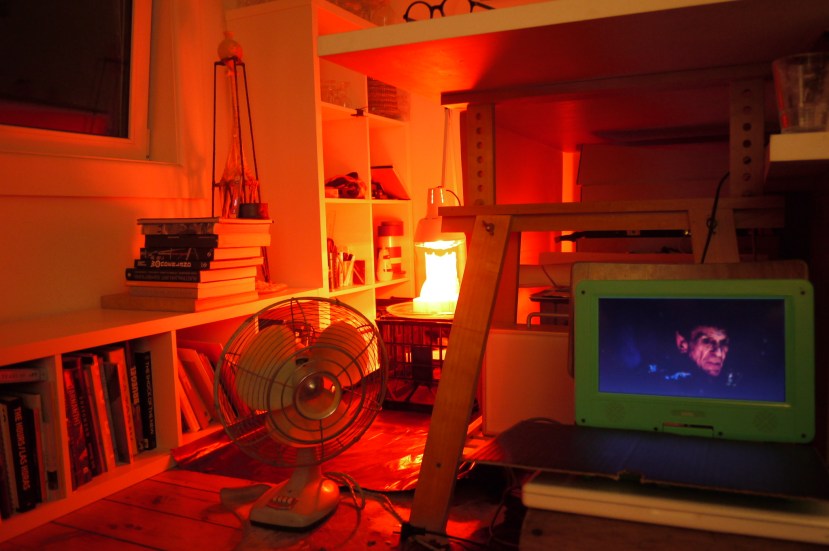
‘Soon it would be too hot’ is a work in progress. Even Mr Spock isn’t quite sure what’s going on yet.
Soon it would be too hot is the first line of JG Ballard’s novel The Drowned World, which I’ve been obsessed with for ages. (See previous responses here)
Soon it would be too hot is also a work in progress. Even Mr Spock isn’t quite sure what’s going on yet.
Watch this space!
Mix and Match City at Hazelhurst (bathroom)

Tracey Clement, ‘Mix and Match City,’ 2020, laser cut recycled cardboard, tape, glue, dimensions variable. Installed in the bathroom of the cottage at Hazelhurst, August 2020.
In late August 2020 I undertook a short stint as artist in residence at the Hazelhurst Arts Centre, staying in the fabulous 1940s art deco ‘cottage.’
I couldn’t resist installing my Mix and Match City in the over-the-top original deco bathroom.
Mix and Match City can be seen in the group show THE HOME at the Hazelhurst Arts Centre until 8 November 2020.
Mix and Match City: Hazelhurst Residency
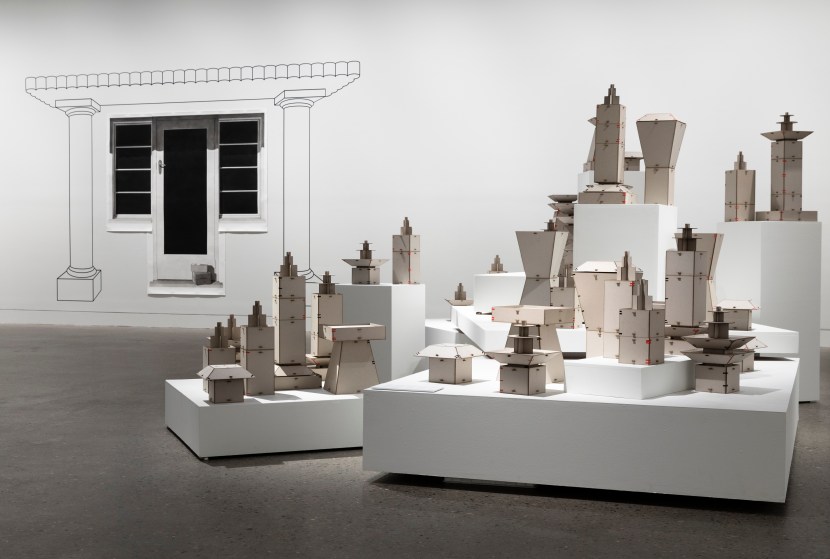
Tracey Clement, ‘Mix and Match City,’ 2020, laser-cut recycled cardboard, tape, glue, dimensions variable (40 units). Installed in ‘The Home’ at Hazelhurst Arts Centre. (Catherine O’Donnell’s work in the background.) Photo: Silversalt.
The multiple little buildings presented in Mix and Match City encompass an eclectic range of styles that were nonetheless all made from a selection of just six basic shapes.
In this model city structures resembling classic art deco skyscrapers from New York or Chicago, Aztec pyramids, adobe masterpieces from Timbuktu, Persian towers, pan-Asian pagodas and suburban Aussie bungalows all coexist harmoniously. And if they can, maybe we can too?
At a time when the notion of home seems more important than ever, Mix and Match City is a mini utopia, a gesture towards a better future.
I constructed this iteration of Mix and Match City while staying the the 1940s art deco ‘cottage’ as artist in residence at Hazelhurst in August 2020.
Mix and Match City was exhibited in the group show THE HOME at the Hazelhurst Arts Centre 29 August – 8 November 2020.
Looking back to the future: Futurama 2.0

Tracey Clement, ‘Futurama 2.0’ (instal detail), 26 October 2019 – 29 February 2020 at Fairfield City Museum and Gallery(FCMG).
Looking back to the future
by Tracey Clement
(A shorter version of this essay was published in October 2019 by FCMG in the exhibition catalogue)
Visitors to the Futurama exhibition at the 1939-1940 World’s Fair in New York left with a souvenir badge that declared, “I have seen the future.” What they had actually seen was an elaborate piece of propaganda; a massive model landscape in which modern metropolises were joined by what their creator Norman Bel Geddes liked to call “magic motorways,” all teeming with cars.(1)
The “Word of Tomorrow” presented in Futurama ranged from life-sized to miniature. It featured more than 500,000 buildings, one million trees, and 50,000 cars, trucks and buses (10,000 of which actually moved).(2) Automobiles, and the roads they zoomed along, were very much the stars of the show. Which comes as no real surprise since the primary purpose of this ambitious display was to sell cars and lobby US government officials to build more roads.(3)
Futurama was a giant advertisement for American automotive giant General Motors. And in many ways the more than five million people who visited had seen the future: a rather bleak future in which personal freedom was conflated with owning a car; a future in which whole neighbourhoods were razed to rubble to accommodate roads; a future of pollution, congestion, the rapacious consumption of fossil fuels and the wars waged to secure their supply; a future of anthropogenic climate change.
The future we are living in now.
I have seen the future
I first felt like I had seen the future when I read JG Ballard’s 1962 novel, The Drowned World. Reading this slim sci-fi story in the mid 1980s, when nuclear Armageddon loomed large, Ballard’s post-apocalyptic vision of a ruined semi-submerged metropolis – strangled by vines, patrolled by carnivorous reptiles and equally dangerous men – seemed both realistic and inevitable. Today The Drowned World reads like a prescient vision of our current climate emergency.
Since 2014 I have been using imagery of the ruined model city in sculptures which seek to draw attention to the dangers of an anthropocentric world view. As these mini cities disintegrate they can be read as warnings; a vision of the post-apocalyptic future we are wilfully creating through both action and inaction. But they, like The Drowned World, can also be seen as a glimmer of hope.
As I have argued elsewhere, Ballard’s post-apocalyptic story can be read as a utopian vision of the slate wiped clean. He pictures a fecund world in which humanity is on the wane while the rest of the natural world flourishes without us. It’s a vision of hope, but one tinged with a deep sense of loss: the loss of humanity in all our terrible brilliance.(4)

Tracey Clement, ‘Futurama 2.0’ (instal detail), 26 October 2019 – 29 February 2020 at Fairfield City Museum and Gallery (FCMG).
Futurama 2.0
A few years ago I heard an author say on the radio that the role of a sci-fi writer should be, not to describe impending disaster, but to imagine a positive future; to envisage utopia, to dare to hope. I can’t remember his name, and I’ve paraphrased him wildly, but it’s a valid point.
Today, as our political leaders put their heads in the metaphorical sand and refuse to address the realties of the climate crisis; as temperatures rise along with sea levels; as so many people suffer from despair in the face of ecological upheaval that Australian philosopher Glen Albrecht came up with a name for the condition – solastalgia, which, perhaps unsurprisingly, didn’t really catch on but eco-anxiety did; as we build yet more roads; as we continue to burn coal: catastrophe seems inexorable. Inevitable. Picturing it is just a little bit too much like stating the obvious.
Imagining a better world is much, much harder.

Tracey Clement, ‘Futurama 2.0’ (instal detail), 26 October 2019 – 29 February 2020 at Fairfield City Museum and Gallery (FCMG).
With Futurama 2.0 I’ve tried to rise to this challenge. It is a utopian vision of the city, albeit a modest and subtle one. Compared to its predecessor this model city is utterly lacking in sophistication. There are no bells, no whistles, no moving parts. Brightly coloured and literally held together with sticky tape, it looks like something kids might make.
There are clues to its utopian leanings scattered throughout Futurama 2.0, but this right here is key: children aged four to 12 years-old did contribute to the project, and so did local high school students, and adults from both the Fairfield and broader Sydney communities. More than 50 people answered my call to come make their mark on this model metropolis. We made the city together.
There are other elements in this artwork that point to its utopian leanings. For a start there aren’t any cars at all; Futurama 2.0 is a walk-able city, with (presumably) an efficient public transport system tucked neatly underground. And the trees are massive, old growth giants venerated for their carbon sequestering, shade-throwing and inherent wisdom. Corporate branding is subverted and re-purposed to suit other agendas. Futurama 2.0 is a conglomeration of classic Western skyscrapers, Aztec-esque pyramids, Middle Eastern style towers, pan-Asian pagodas and suburban bungalows all coexisting harmoniously; a kind of multicultural architecture made from just six basic shapes. But the collective nature of its construction remains its most potent symbol of hope.
For it is together that we have the power to shape the future.
Tracey Clement 2019
Notes
- Norman, Bel Geddes, Magic Motorways. New York: Random House, 1940.
- The theme of the fair was “Building the World of Tomorrow. Donald Albrecht, ed. Noman Bel Geddes Designs America, New York: Abrams, 2012, 290-294.
- It was very successful. See: Nathaniel Robert Walker, “American Crossroads: General Motors’ Midcentury Campaign to Promote Modernist Urban Design in Hometown USA,” Buildings & Landscapes: Journal of the Vernacular Architecture Forum 23, no. 2 (Fall 2016): 89-115.
- Tracey Clement, “Mapping the Drowned World.” University of Sydney, 2017, 190. http://hdl.handle.net/2123/17344
 Tracey Clement: Futurama 2.0
Tracey Clement: Futurama 2.0
Fairfield City Museum and Gallery (FCMG)
26 October – 29 February 2020
Banquet
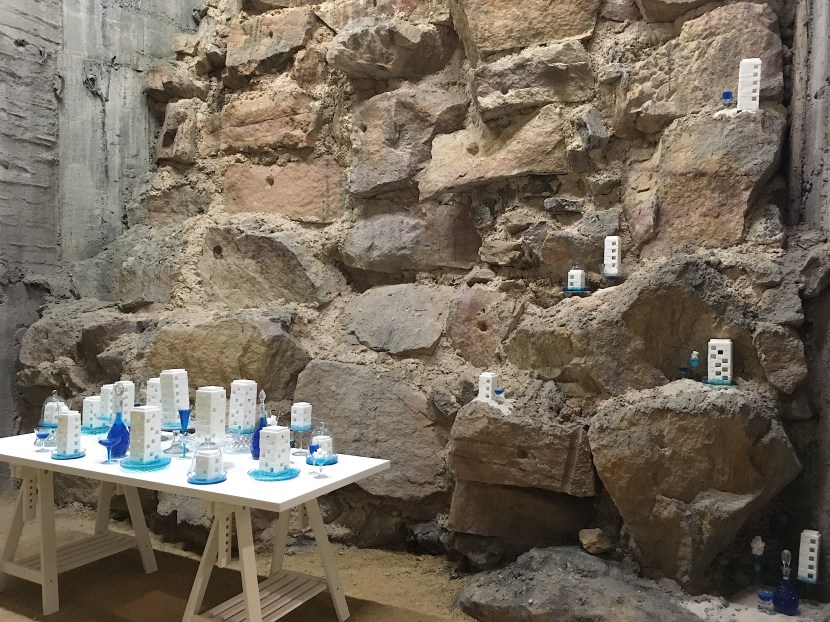
Tracey Clement, ‘Banquet,’ installed in at the Coal Loader Centre for Sustainability as a finalist in the North Sydney Art Prize, 2-17 March 2019, sugar, glass, laundry soap, dimensions variable.
The word banquet implies abundance, but also gluttony and greed. Like much of my recent work, Banquet uses the symbol of the ruined city to highlight the impact of an anthropocentric worldview.
The brutalist towers of Banquet are made from sugar cubes. Perched on fancy cut crystal glassware, they are flooded with laundry soap. They tilt, crash and dissolve over time.
Sugar is sweet, but it is also addictive – another white powder. The toxic legacy of the sugar industry (driven by our mass consumption) ranges from slavery to bleached coral on the Great Barrier Reef. And as the bright blue laundry detergent in this sculpture undermines the foundations of the city, it is a reminder that what goes down the drain ends up in our rivers and oceans. All of our actions have implications for an environment with which we are inexplicably entwined.
Banquet is part of my ongoing series of miniature cities.
Soft Science at Sheffer Gallery

Tracey Clement, ‘Soft Science Diagram’ (detail), 2018, vintage laboratory glass, knitted and wound acrylic yarn, MDF, pine.
Tracey Clement: Soft Science
Sheffer Gallery
38 Lander Street
Darlington
12 – 22 December 2018
Weds – Sat, 11am – 6pm
Tracey Clement is known for creating artworks that meticulously utilise labour intensive techniques for their conceptual resonance. In Soft Science she turns her attention to knitting, a skill still largely regarded as women’s work.
In Soft Science, when the domestic feminine act of knitting is made an integral part of a laboratory experiment, we are asked to acknowledge two truths: that women have always made a significant contribution to the supposedly masculine domain of science, and that the hard facts of science are not the only way to make sense of the world.
Soft Science highlights the fact that there is more than one way to skin Schrödinger’s cat. In a secular society we tend to look to the quantifiable facts of science for meaning. But art too is a way of understanding the world; a knowledge generating system which is different, but no less valid.
In Soft Science, when cold rational laboratory glass meets soft warm knitting, fuzzy logic is made manifest. In other words, there is no right answer in an experiment calculated to prove, if it proves anything at all, that truth is a mutable concept and that much of the universe may be ultimately unknowable.
Winner: 65th Blake Prize Established Artist Residency
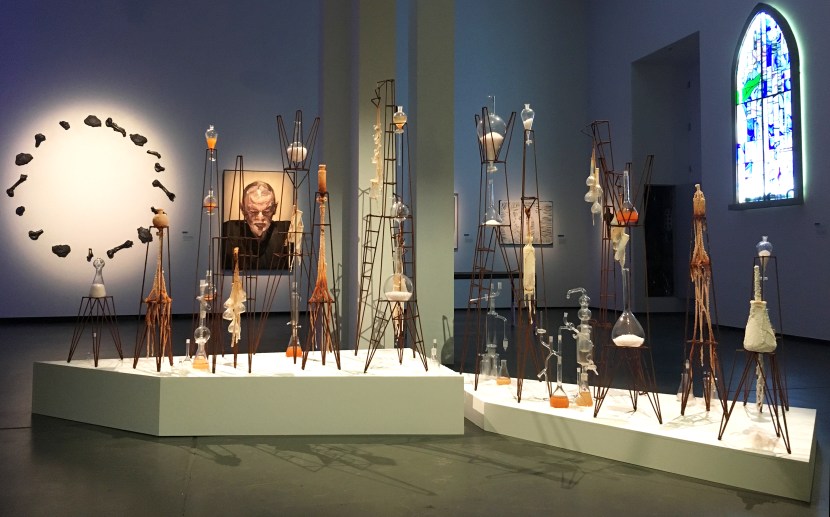
Tracey Clement, ‘Metropolis Experiment,’ 2017-2018, rusty steel, lab glass, salt, cotton. Installed at Casula Powerhouse for the 65th Blake Prize, 2018.
Thanks to Metropolis Experiment I’ve won the 65th Blake Prize Established Artist Residency!
This prize includes a 4 week residency and a solo show at the Casula Powerhouse in 2021!
Watch this space!
